Menu
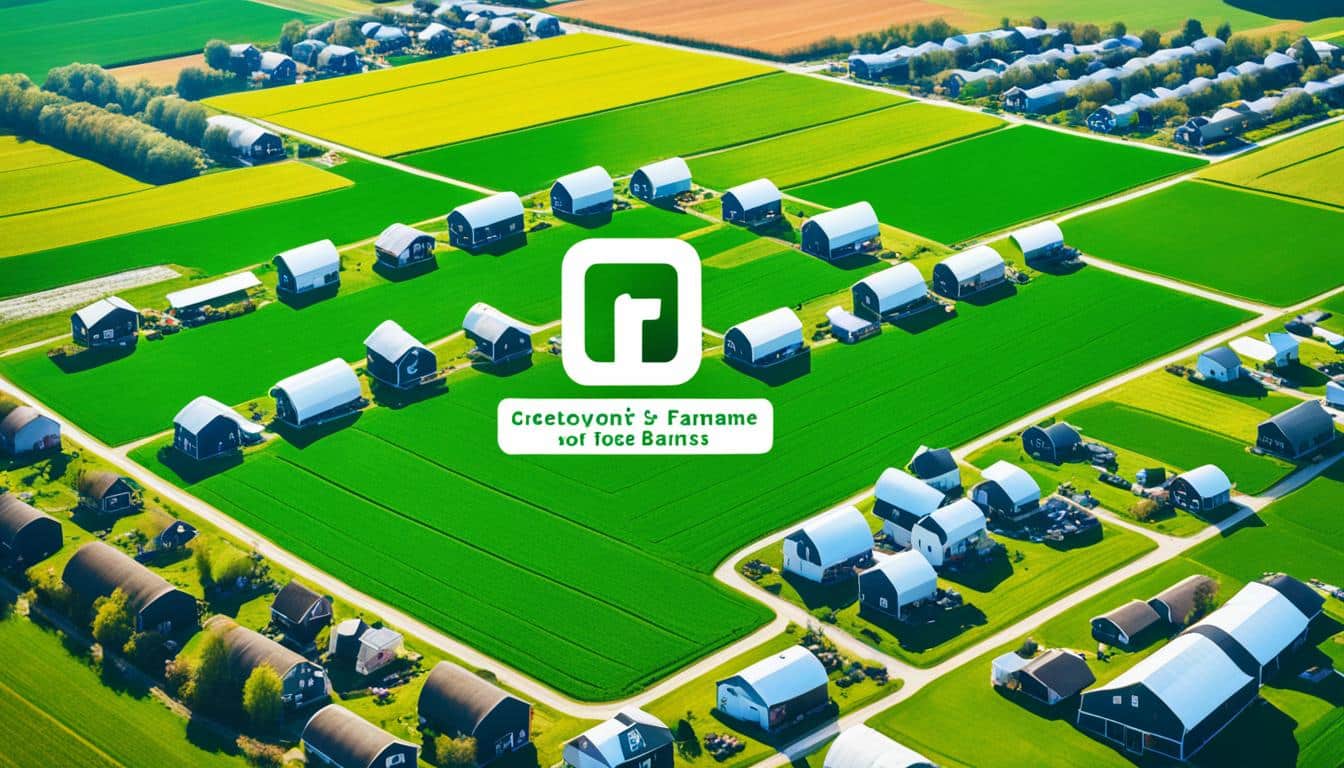
Did you know that social media posts with photos get 75% more likes? This amazing fact shows how important visuals are for your farm’s online image. In today’s world, having a strong social media strategy is key for farms of all sizes. A good social media plan attracts both old and new customers to your farm.
Penn State Extension suggests managing a strong presence on sites like Facebook. Being able to post and share with your customers can widen your reach. Keeping your farm’s online info up-to-date and consistent is vital too. This ensures people always get the right details when they look for you.
With a well-thought-out social media plan, your farm can compete online and engage with customers effectively.
Social media is vital for farms that want to connect with their customers. Research shows that more than 70% of adults use social media. This means using platforms like Facebook, Instagram, and YouTube is key for reaching people.
Since its start in 2004, Facebook has been a favourite for many. Its features like posts, shares, and likes help farmers build a bond with their audience. Instagram, on the other hand, offers unique tools for business accounts to increase brand awareness.
Showing your farm visually is extremely effective. The brain processes images quickly, with Instagram focusing on this aspect. Videos are also great, which is where platforms like YouTube come in. Farmers can make channels to share their stories and promote their work.
To keep people interested, aim to post on social media three to four times each week. Use hashtags to make your posts more visible. It’s also smart to check when your posts get the most attention so you can post at the right times.
Using features like tagging, hashtags, live streams, and auto responses makes your interactions more fun. Quickly answering comments and messages shows you care about your followers. This all helps build a strong relationship with your community. It’s a great way to keep everyone updated and interested in what your farm does.
It’s key to set clear goals for your social media plan. These goals are like a blueprint. They help measure success and adjust your steps. For promoting agribusiness online, a solid plan focuses your work and boosts outcomes.
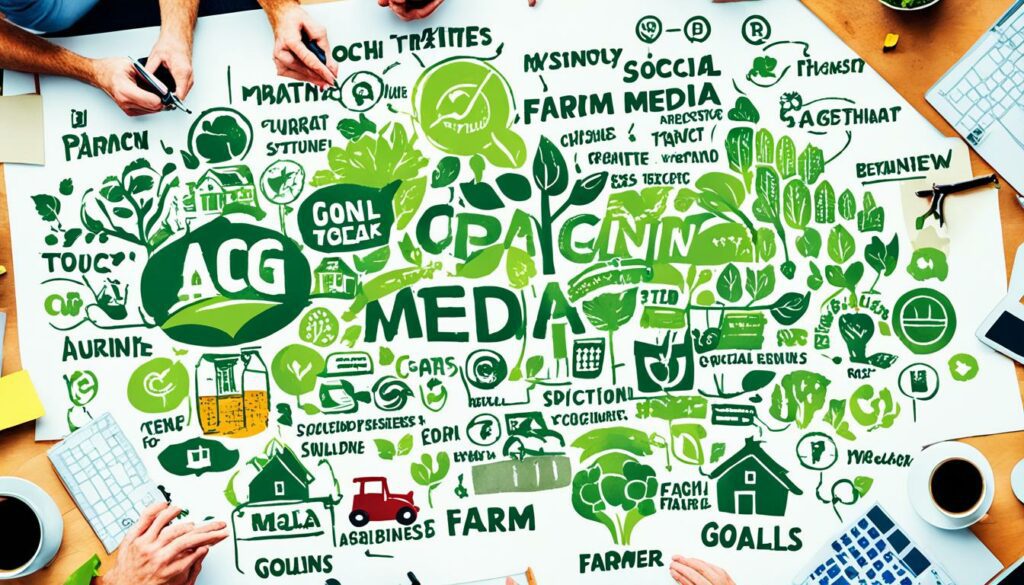
Know your main business aims to shape your social media work. Want to sell more, better your service, or talk about green farming? A clear goal helps in creating fitting content and ways to connect. It keeps you on track with your big business goals too.
Getting your audience right is key to what you share and how. Each social platform has its own crowd. YouTube, for example, is used by 73% of U.S adults, while Instagram mainly sees 18-29-year-olds, reaching 37%.
Figuring out the right crowd means you can choose the best platforms. It also helps you make messages that click, like highlighting farming that’s kind to the earth or showing off new agri-tech.
Make sure your social media goals match your business aims. This way, every post and like brings you closer to what you want. Want more people at your events? Use Facebook which many people use. Looking to sell more straight to customers? Try Pinterest, which is popular too.
Keeping your social media in line with your business helps your farm’s image and growth. By connecting your business goals, target audience, and social media, you build a powerful plan. This not only boosts your agribusiness online but also helps spread the word about green farming in a big way.
Choosing the best platforms can make a huge difference in farm marketing. You need to know the latest in agritech social media to get to more people. Instagram is very popular, with 2 billion users and a lot of daily use. It’s important to post regularly and use tactics like Instagram 5 to keep people interested.
Facebook, Twitter, Snapchat, Pinterest, and Instagram have tools that can support different content types. It’s a good idea to show a special product each week, share what goes on behind the scenes, and feature posts made by users.
So, let’s look at how different platforms compare:
| Platform | Category | Key Features | POS Integration | Shipping Options | Wholesale Functionality |
|---|---|---|---|---|---|
| Shopify | Mainstream | Extensive add-ons, shipping | Yes | Yes | Yes |
| Square | Mainstream | POS integration, shipping | Yes | Yes | No |
| GrazeCart | Specialised | Sell by the pound, online shop | Yes | Yes | No |
| Barn2Door | Specialised | Sell by the pound, shipping | Yes | Yes | No |
| Local Food Marketplace | Specialised | Food hub management, CSA functionality | Square POS | No | Yes |
Knowing who your audience is and how they use social media helps you pick the right platforms. Using a mix of common and specific platforms can make buying and selling easier, and it can increase sales too.
Getting help from agriculture influencers can make your messages reach farther and be seen as more reliable. The experts at WebFX can guide you, making it easier to excel in digital marketing. Staying up-to-date on agritech social media helps you stay ahead and grow your farm’s online presence.
In the digital world, it’s key to create content that your audience truly connects with. Using different content types like photos, videos, and stories helps. They make your followers really engage with what you share. This can lead to a strong community around your farm online.
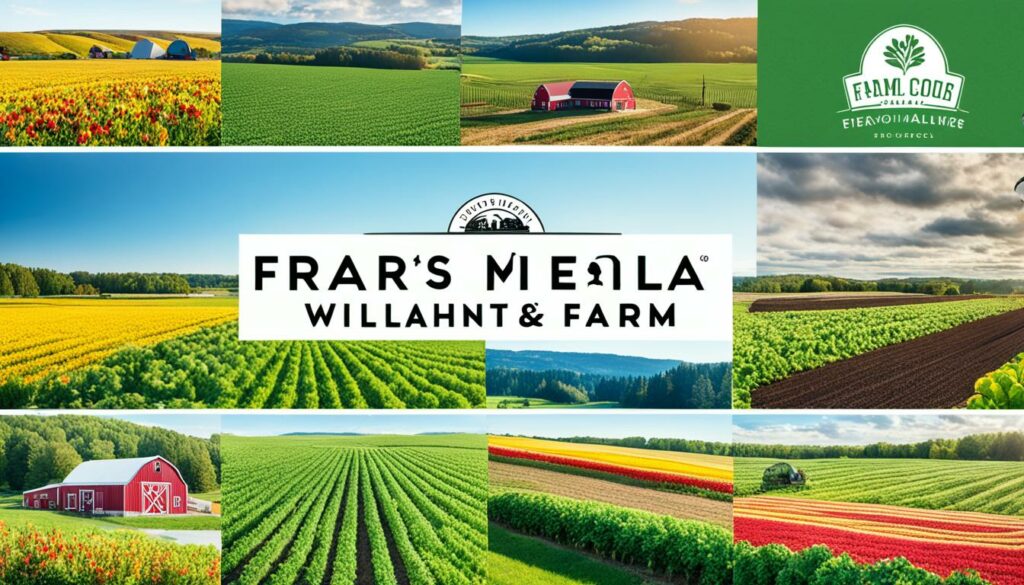
For a great social media presence, you need dynamic types of content. Sharing photos of your farm from daybreak to the end of the day builds a personal link with your fans. Videos target a wider range of viewers, especially on YouTube. It’s a platform where 73% of US adults check in, and almost all young adults up to 29 years old use it.
Visual content is vital for grabbing and holding people’s interest. On places like Instagram, where 67% of young adults take part, good-looking posts get more likes. This includes beautiful photos and how-to videos. By focusing on quality visuals, your farm’s brand can really shine online.
It’s great to mix educational and fun stories in your content. Educational posts can cover tips on sustainable farming or advice on looking after crops. They attract fans keen to learn. On the flip side, fun stories or inside looks into farm life draw in a wide audience. It ranges from those in cities watching on YouTube (77%) to people in the countryside sharing on Facebook (66%). This mix helps to build a solid and interested group of followers.
In farming social media management, creating a brand voice is key. It means showing who your farm is and what it stands for. This helps you connect with people and stand out from the crowd.
Start your farm branding social media with your farm’s special points. Things like your way of farming or the animals you keep. Talking about these in your posts will help define your brand’s voice.
Being consistent across social media is very important. Your farm’s unique qualities should show everywhere. For example, if you focus on being eco-friendly, share that message on every platform. This builds a strong image for your brand.
“Tagging (@) and hashtags (#) are essential for expanding your farm’s reach and grouping similar posts together, fostering a broader community engagement.”
Making a personal connection with your followers is vital. Talk in a way that feels true to your farm. Respond to comments and share your daily farm life. This makes people feel they know the real you.
It makes them more likely to buy from you.
| Platform | Feature | Benefit |
|---|---|---|
| Live Broadcasts | Real-time engagement | |
| Stories | Short-term, engaging content | |
| Hashtags | Group similar posts |
Using these social media tools well can make your farming social media management even better. It helps you connect directly with your audience.
It’s essential to connect with the agricultural community. This helps improve rural community engagement and boosts agribusiness online promotion. By working closely with local producers and connecting with customers, strong relationships are built.
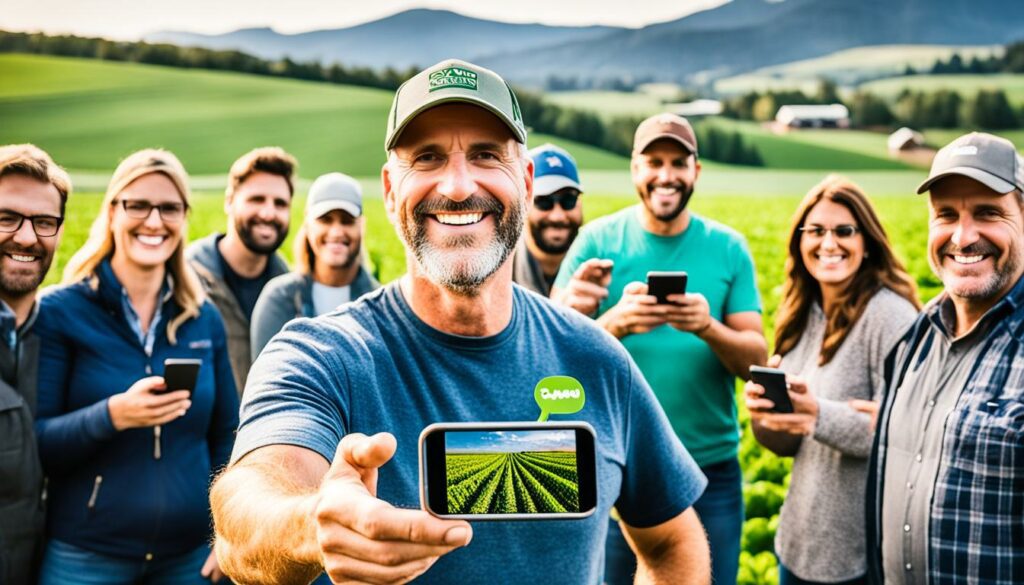
Did you know, over 70% of adults use social media? Platforms like Facebook and Twitter offer great ways to reach out. Engaging with your community online encourages teamwork, support, and sharing of good ideas, which then makes your online promotions better.
Here are some key tips to consider:
Engaging with the agriculture community also improves your presence online. With brief attention spans, capturing people’s interest quickly is crucial. Stunning images can grab someone’s attention in under 0.02 seconds. This shows the amazing effect visual content has on drawing attention.
Moreover, working with experts can really boost your online campaign. Companies like WebFX have over 28 years of experience. Their help can make your social media strategies more effective, meeting your online goals with success.
Today, using analytics is key for a strong farm digital marketing plan. Platforms like social media offer lots of data to check your success online. They can help farmers refine their social outreach for sustainable farming.
There are many social media metrics to understand. Some key ones are reach, engagement rate, and follower growth. In 2012, Neiger et al. classified metrics into KPIs and aligned 39 metrics. This framework is useful for checking digital campaign success. But, it’s important to know which metrics really show your impact.
Collecting data isn’t enough; farmers need to use it too. Social media analytics can help predict outcomes in agriculture and other fields. Using this data, farmers can change their content and schedules to be more effective. In 2018, the AgriTech sector saw $17 billion in investments, showing how important data is in farm digital marketing.
Using insights from social media data can really boost your engagement. For example, by using data in agriculture, there’s a chance to save $2.3 trillion. This helps in forecasting crop production and improving yields. It makes social outreach for sustainable farming more focused and successful.
| Year | Investment in AgriTech ($ Billion) | Savings Potential ($ Trillion) |
|---|---|---|
| 2018 | 17 | 2.3 |
| 2023 (Forecast) | 1.236 (Analytics Market) | Up to 250 (AI & Analytics) |
| 2030 | N/A | 155-405 (Food Waste Reduction) |
By using a structured approach with analytics, farm digital marketing becomes more efficient and successful. This leads to a strong and long-lasting social outreach for sustainable farming.
Managing social media accounts well is key for any farm’s content plan. Over 70% of adults use social media. So, posting regularly is essential to stay visible and connect with followers.
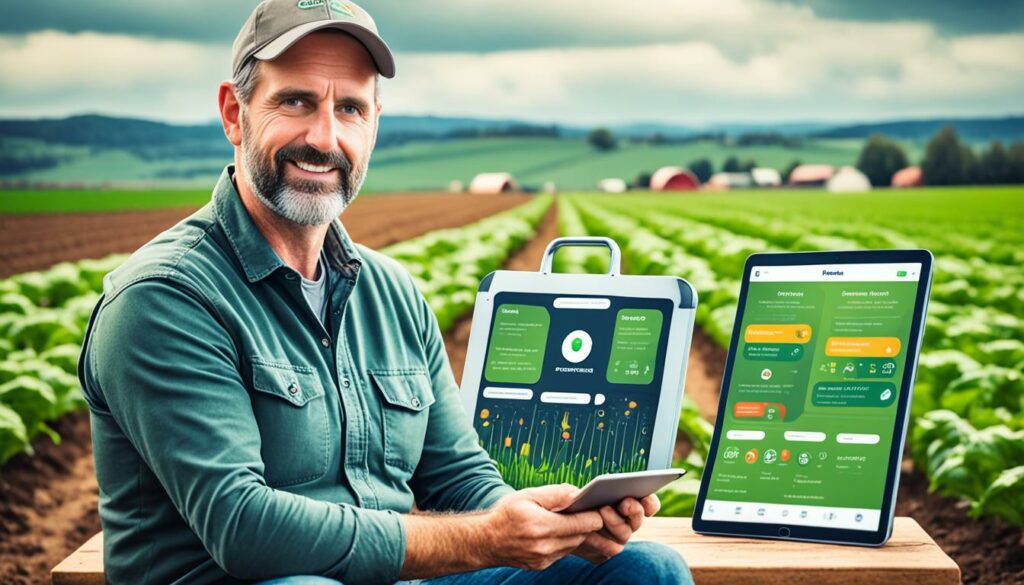
Posting often helps your farm stay top of mind for your audience. People’s attention span is short, about 8.5 seconds. So, share interesting photos, videos, and stories to grab their attention. Planning your posts in advance helps keep your farm active online, even during busy times.
Tools like Hootsuite and Buffer are great for planning your posts. They let you schedule posts on Facebook and Instagram in advance. This ensures your content reaches the most people when you’re busy with farm work.
It’s vital to interact with your followers quickly and in a thoughtful way. With over 2 billion users spending 28 minutes daily on Instagram, it’s essential to engage with them. Quick replies to comments and messages create a community vibe and boost customer loyalty. Don’t forget to tag relevant pages and use popular hashtags to reach more people and start conversations.
By using these approaches, you can boost your farm’s online visibility and attract more customers.
Developing an effective social media plan for your farm is key. It’s necessary for online agribusiness promotion. Understanding and using various platforms are part of this. So is setting clear goals and making interesting content. Facebook, since 2004, is still a top choice. It has many users. Instagram, started in 2010, is good for businesses. YouTube is great for farm videos.
Images are vital in a farm’s social media strategy. Posts with photos get more likes and shares. Use Canva, Hootsuite, and Buffer for visuals. They can help you keep a regular schedule. Aim to post three to four times a week. This helps you stay in touch with your audience.
Talking to your followers is another important step. Get them involved by sharing recipes or using certain hashtags. Stories about your farm can also make personal connections. Always respond to farming questions. This boosts your trust and connection with followers.
Staying up-to-date on topics like seasonal produce is crucial. Checking your social media daily helps you engage with followers promptly. Use hashtags wisely to boost post visibility.
Adding expert advice and analytics can make your plan even better. It ensures you have a strong, consistent online presence. This helps your overall business goals and keeps customers loyal. Your agribusiness will benefit greatly from this approach.
Promoting events on social media helps farms grow. It brings people in the countryside closer together. Various tools on social media make it easy to show events, build excitement, and talk with customers.
Live broadcasts connect you with people right there. Most adults use social media. So, live videos can really be seen by a lot of folks. It shows farms are open and honest, fitting well with farm influencer efforts. It makes for lively chats, with viewers asking questions and giving feedback, which makes the community stronger.
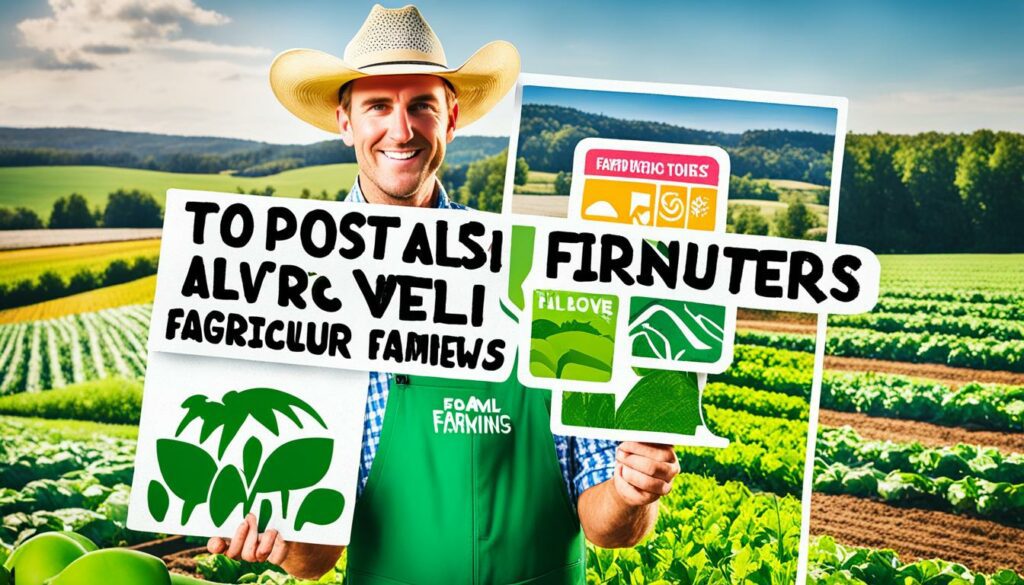
Content made just for events is key. It gets people excited and aware. Visuals work great. The brain can see photos in less than 13 milliseconds. Use photos, videos, and graphics to grab attention. With people’s short focus these days, you need to be quick. Use special social media tools to boost the event’s visibility. Things like tags and stories make a big difference.
Talking to your audience during events makes it better. Update them in real time, do polls, and chat after the event. This makes social media interactions stronger. More talk means more people see your farm. The goal is to turn watchers into customers. Speaking in a clear, unique way helps your farm stand out and build trust.
Working with agriculture influencers is now a key strategy in farm marketing. It shows how reaching out through them can boost a farm’s influence and trust. Influencers like David Cogen, known on YouTube and Instagram, help farms reach fresh, engaging communities.
Cogen partnered with John Deere, aiming to inform people about farming and tech solutions. Chelsey Erdmann supports Cogen in showing real, sustainable farming practices. They both connect with their followers, making the farm’s story more personal and engaging.
Techniques like SEO and content marketing make agriculture influencer campaigns more powerful. They ensure the influencer’s message strengthens the farm’s brand online. This way, farms can boost their online visibility while keeping true to their values.
Examining social media data is vital in measuring these partnerships’ success. By looking at how engaged people are and how the farm’s following grows, insights are gained. These help to improve influencer campaigns, reaching more people effectively. Choosing influencers who share the same values as the farm can make a big impact, aiding in sustainable farming outreach.
Bringing social media together with marketing plans is key. It makes a smooth and fun brand experience for customers. It allows farms to reach more people. They use the best of online and offline marketing. This way, each type of marketing works better.

Email campaigns really work. They can work even better with social media strategies. By putting social media links in emails, farms get more people to check out their social pages. This gets more people involved and grows the farm’s online audience.
It also helps email subscribers find the farm on places like Facebook and Instagram. This starts a cycle of always keeping in touch.
Using many social media platforms together is very powerful. With Facebook, Twitter, and Instagram, you can reach millions every day. By sharing posts on all of them, farms make sure they talk to as many people as possible. This also keeps their message about the farm consistent.
Printed items are still very useful in agriculture. Adding social media info to flyers, brochures, and cards connects offline and online. This keeps customers linked to the farm’s news and events, even after they first meet.
A strong content strategy in agriculture combines digital and print work. It makes the farm stand out well. The table below shows tips on how to mix social media with other marketing well:
| Strategy | Benefits | Examples |
|---|---|---|
| Coordinating with Email Campaigns | Increases social media followers, boosts email engagement | Including social media links in email footers |
| Cross-Promoting on Different Platforms | Expands reach, maintains messaging consistency | Sharing Instagram posts on Facebook and Twitter |
| Leveraging Printed Materials | Bridges offline and online presence, maximises engagement | Adding social media handles to brochures and business cards |
Mixing social media with old-fashioned ways, like agritech social media trends suggest, makes things better. This way, every way you reach out to customers is more powerful. It helps connect better with the people you want to talk to.
Farm digital marketing has its own hurdles. To navigate them, it’s crucial to address negative feedback, keep a professional image, and stay flexible with platform changes.
Receiving negative comments is part of the game. But, responding with grace can change critics into supporters. Engaging with concerns in a quick and friendly manner is vital. It shows dedication to making things right and boosts your farm’s image.
Being professional online is key for farm marketing success. Ensure your messages and tones match your farm’s beliefs and principles. This builds trust and credibility with your audience.
Social media is always changing, and keeping up is a must. Adapting keeps your marketing efforts fresh and effective. Stay updated and use new features to keep your audience engaged and your online presence growing.
| Platform | Usage Among U.S. Adults (%) | t
|---|---|
| YouTube | 73% | t
| 69% | t|
| 37% | t|
| 28% | t|
| 27% | t
Tackling these issues head-on helps your farm marketing thrive. By embracing feedback, staying professional, and adapting to changes, you lay a strong foundation for success in social media management.
Developing a social media plan for your farm is key to improving your online agricultural presence. It involves setting clear goals and making content that connects with people. Farmers need to use analytics to make smart choices. A good social media plan for your farm looks at the chances and challenges of going digital.
By making interesting posts like photos, videos, and polls, farms can make real connections with people online. Using questions is a smart strategy. But, challenges like account suspensions and algorithm limits are there sometimes. Still, asking questions and using emojis can boost how people interact with your content.
AI on LinkedIn makes creating ads easier. Polls are also popular on LinkedIn and X. These new tools show how social media for farming is always changing. They can help farms promote online. Farms like Laughing Fork Farm have seen big jumps in sales and followers with good digital marketing. For the future, having a flexible and strong social media plan is vital. It will help your farm stay successful and appealing online.
Define your business goals first. Then, identify who you want to reach. Choose the best social media platforms for your farm. Make sure your goals align with your business strategy.
Social media helps farm businesses connect with a wide audience. Platforms like Facebook and Instagram allow you to share your story. You can engage with customers and build a loyal followin.
Be consistent with your posts and use tools to schedule them. Reply quickly to comments and messages. This keeps you visible and helps grow your online community.
Photos, videos, stories, and educational posts are great for engagement. Visuals grab attention and can tell your farm’s story quickly. Aim to share content that your audience will connect with.
Start by defining what makes your farm special. Make sure all your messages tell the same story. By being true to your farm’s values, you can create a strong online brand voice.
Engaging with other in the farming community can boost your visibility and build relationships. It’s a chance to share knowledge and learn from others. This interaction can add depth to your online presence.
Analytics show how well your posts are doing and who you’re reaching. By understanding these insights, you can adjust your strategy to do better. This can lead to more effective social media use.
Partnering with influencers can make more people aware of your farm and its values. This is because influencers introduce your brand to their followers. It’s a great way to reach new audiences in an authentic manner.
Mix your social media with your email and other marketing. Promote one on another to build a strong brand message. Also, make sure your social media is on all your printed materials. This makes for a consistent and far-reaching marketing strategy.
Deal with negative comments respectfully and professionally. Doing so helps keep up your farm’s good name. It also shows you care about your customers and value their feedback.
Talk about events like farm tours and workshops. Share content specifically made for each event. Engaging with people online during these events can make them more popular and strengthen community ties.